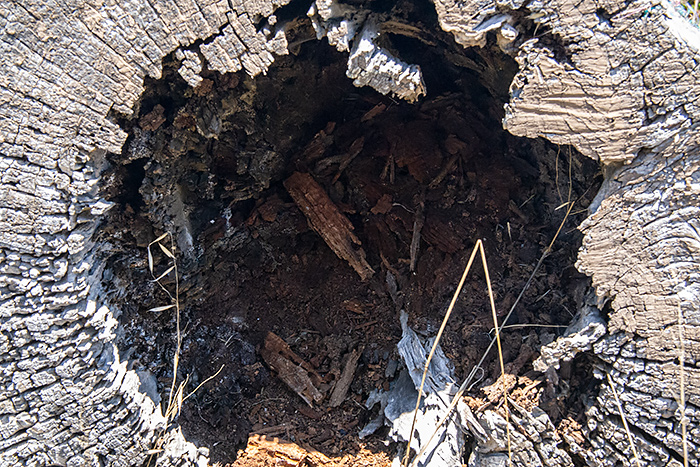Photo Corners headlinesarchivemikepasini.com
![]()
A S C R A P B O O K O F S O L U T I O N S F O R T H E P H O T O G R A P H E R
![]()
Enhancing the enjoyment of taking pictures with news that matters, features that entertain and images that delight. Published frequently.
The Hollowed Out Log



14 August 2019
It's been unseasonably warm this week. For a summer in San Francisco, anyway. So we took a hike on Monday to get as far away from a frozen daiquiri as we could.

The Hollowed Out Log. Captured at f8, 1/100 second and ISO 1000 with the Olympus 12-200mm f4 Pro on the Olympus E-PL1. Processed in Adobe Camera Raw.
We also wanted to shoot with the Olympus 12-100mm zoom on some distant targets and Twin Peaks seemed like the best place to do that. Within walking distance, anyway. So up the hill we went.
Oh, yes, it's a hill, not a mountain. We learned that the other night watching The Englishman Who Went Up a Hill but Came Down a Mountain, which is the story of two cartographers who made the mistake of classifying a beloved Welsh mountain as a hill because it didn't exceed 1,000 feet in altitude.
Same problem here. Our three tallest hills are all (barely) under 1,000 feet.
The Welsh did something about it. They piled up some dirt despite a storm and made the grade. San Franciscans, not very obsessed with size by nature, have never bothered.
We keep busy with other pursuits. In our case, we thought we'd hunt down the old tree stump we used to photograph as part of our digicam reviews.
It's still there and we did photograph the sun-bleached wood. Time has not been kind to it either, of course. So we kept walking (it's the only way to get home from there) and came upon this hollowed out log.
That halo of bleached wood surrounds, well, nothing.
Hollowed out logs are craftsy. People use them as planters. And bird houses. And bee hives. Amazon even sells them.
We, however, took it as a sign of the times.
That halo of bleached wood surrounds, well, nothing. The emptiness of self absorption, if anything. We lined it up and got our shot.
Funny thing about taking a hike. Your mind wanders. We flashed on thoughts of Gilroy, El Paso and Dayton. How could we not. The state of the nation. Racism. The dismantling of environmental protection. A growing list of worries.
We felt the need to switch gears. As we walked down the hill, we remembered a very strange story we'd read about redwoods.
Redwoods live up to 2,500 years. No time for hollowing out, really. And their genomes have 32 billion base pairs compared to our own 3.2 billion, which makes them more sophisticated than mere mortals.
And just to prove it, there's the case of the albino redwoods.
In Mysterious 'Ghost Redwoods' May Survive to Help Nearby Trees, Melissa Breyer talks to biologist Zane Moore from the University of California in Davis about these odd white redwoods.
They shouldn't exist. They have no chlorophyll, the green pigment that allows plants to make food from light through photosynthesis.
But they get life-sustaining sugar from nearby redwoods whose roots network beneath the soil. So they survive.
Are they parasites? Far from it, Moore suggests.
After analyzing albino needles, Moore discovered the albinos suck up all the poisons in the soil: cadmium, copper and nickel. The two races need each other. And help each other.
It's just a theory, Moore admits.
Our hollowed out log was not so lucky. It stood alone, proudly perhaps, for years even as it was rotting from within. Until one storm one day finally beat it down.
And now anyone can see that inside it was as empty as a hollow promise.